A trope about samurai swords is that they are incredibly strong and sharp.
In fact, they are typically sharp, depending on the blade geometry. What makes a blade cut is the weight or pressure behind it, the thinness of the edge, and the degree to which the material supporting the edge is arranged so that it doesn’t bind going through whatever it’s cutting. “Thin to win” is an old knife-maker’s saying and it’s why kitchen knives are thin: they don’t need to smash through armor in order to get to the carrot meat inside. The reason a samurai sword is sharp is because the Japanese generally pay intense attention to detail regarding their swords – and that applies to sharpening them. Interestingly, a Japanese blade polisher doesn’t exactly “sharpen” a sword; they simply return the grind to its original shape, and burnish the edge. If the original shape and edge was sharp, the results will be sharp, too. It’s a bit hard to visualize how that works, but basically everything about a Japanese blade is intended to lead toward it being sharp and, as long as it is properly maintained, it will be. Take a look at the planes that form the edge and continue the planes until they come into contact and you’ll find its a sharp angle. Of course if there’s a chip or ding, you’ll wind up with a dull spot.
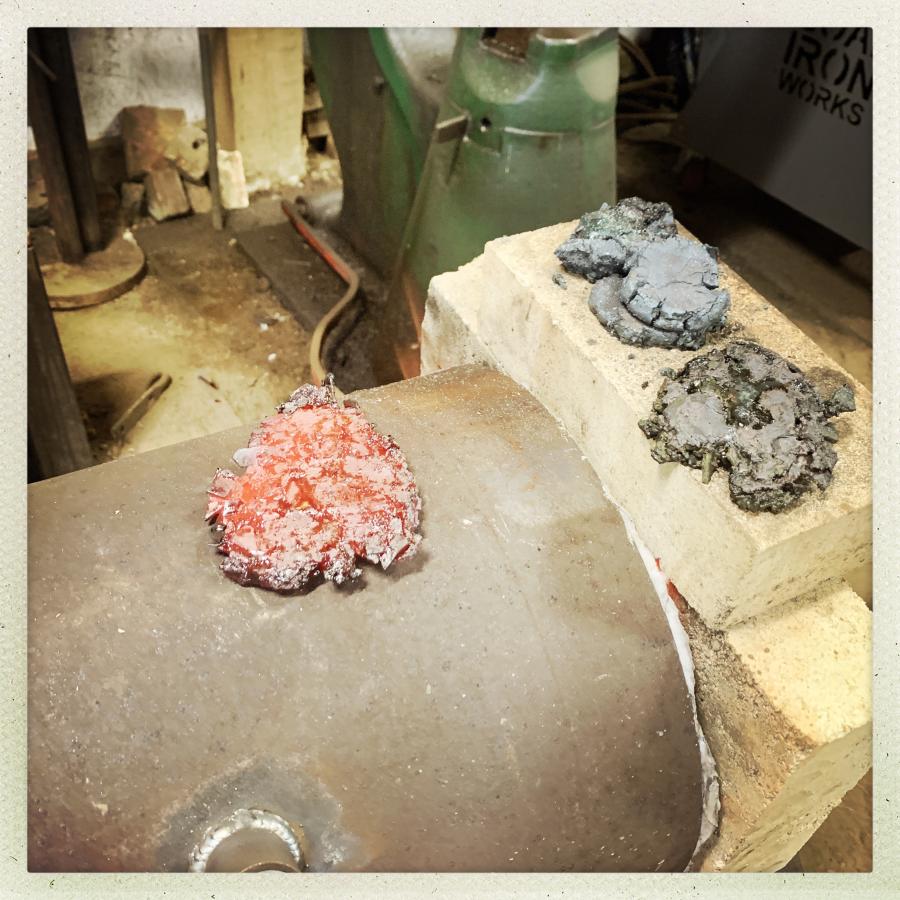
hell cookies at 2200F
The next step in the process is to take the foamy bits of steel (formerly iron) and squish them flat in the press. Once that’s done, they are stacked together, fluxed, and welded into a sort of puck-like billet attached (with a simple weld from a stick-welder) to a handle – a chunk of rebar. In the traditional Japanese process, this is done with a sort of paddle-like thing, which is made from pieces of steel that were processed earlier. Instead of using borax flux, the traditional process wraps the paddle and cookie-chunks with cloth soaked in clay (keeps air away) and glassy clay that helps serve as flux.
Welding is all about temperature, pressure, and keeping air out of the contact-point. In this case, we had a huge advantage in the form of the Coal Iron forging press that Dragonfly Forge recently acquired. I’ve been using a forging press (16 ton) since I started blade-smithing and was immediately converted. In this stage of the process, a smith using a hammer would be making little tiny careful taps on the material, trying to merge it gently – but with a press you just heat it and squash it and it’s welded. This is a huge safety plus, as well: hitting red hot steel with a hammer near someone else’s hand can be problematic.
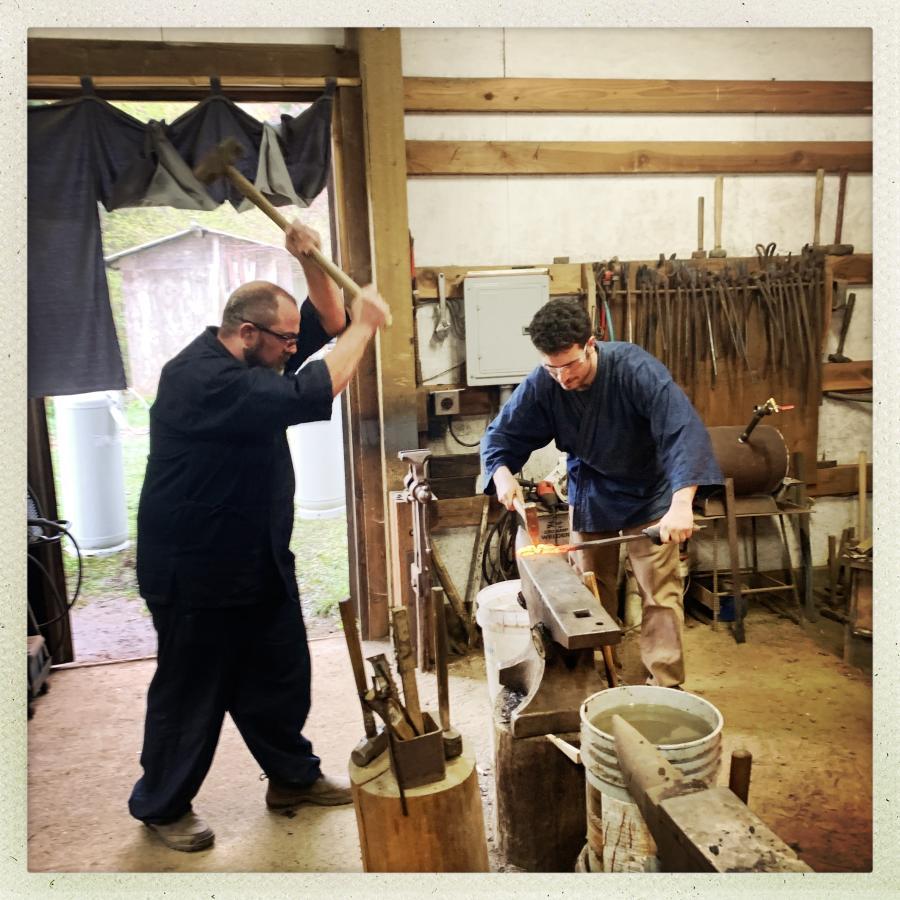
Gabriel is holding a hot cut tool, while Chris whacks it with a sledgehammer. It takes about 10 good whacks to cut across a billet of yellow-hot steel. Once it’s mostly cut, Gabriel will flip it over onto the edge of the anvil, and Chris will put the head of the sledgehammer on it to weight it, while Gabriel taps it a few times to start the metal folding where the cut-line was made. That’s the old school way of doing it.
When I hot fold a billet, I have a little cutter-thing that I made by putting a block of hardox (shock-resistant stainless) in the bandsaw at an angle, so it would cut a wedge-shape – then I drilled the block, tapped it, and added a handle. When I want to hot cut something, I put the metal in the press and squish the wedge through it, then let the press grip it while I start the fold at the cut-line. It’s a lot easier for one person and I think overall it’s safer than having someone swinging a sledgehammer anywhere within 6 feet of my head or hand. Traditionalists, like the Dragonfly Forge guys, are a bit hard to turn around, sometimes, on these things. On the other hand, they’re my teachers and they know a whole lot about this stuff. Nothing justifies itself like success. But, then again, the ancient Japanese smiths would have cheerfully used hydraulics if they had them.
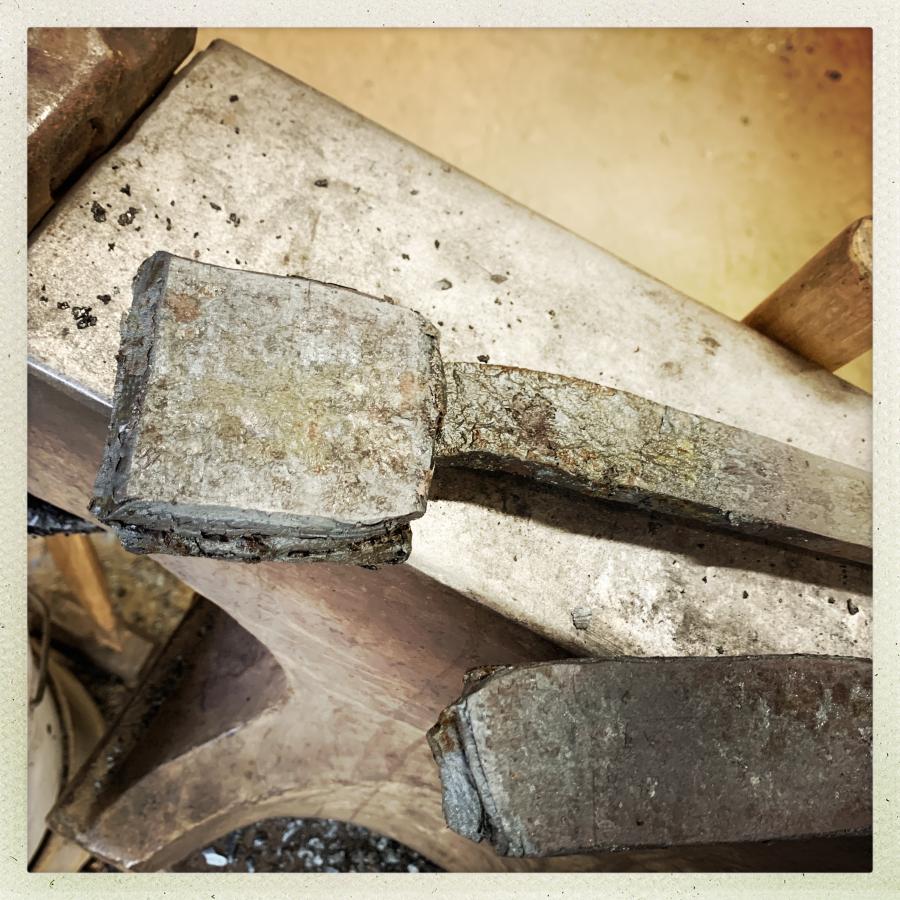
This is where the folds in Japanese swords come in. It’s not doing any sort of magic, what it’s doing is evenly distributing the carbon through the metal, via migration. It also drives out any “cold shuts” – spots where the welds did not take. Interestingly, you can hear them when the billet is being pounded. They sound like kind of dead spots that don’t “ping” like the rest of the steel. Another fun part of folding is when you get a pocket that has inclusions of charcoal, it makes like a little 4th of july firework and spits out a pretty vigorous stream of sparks. Figuring out the number of folds to do is a question of how tight you want the metal’s grain to be. The grain will be a result of the “waves” of carbon driven through the metal. We did 10 folds, so the grain is very tight (that’s 2^10 layers!) The layering doesn’t do anything magical to make the metal stronger, it’s just a refinement trick, but the more refined the steel is, the stronger it is.
Once the billet was formed, it was chopped into 4 pieces and welded to handles. then we pulled out a bunch of books of pictures of Japanese blades, and looked at geometries of tantos throughout history. A typical tanto blade has the distinctive clipped tip of Japanese blades (curved, not straight) and is short, slightly curved, light, and strong. Naturally, there are a variety of forms. I immediately fell in love with what is called an “osoraku”.
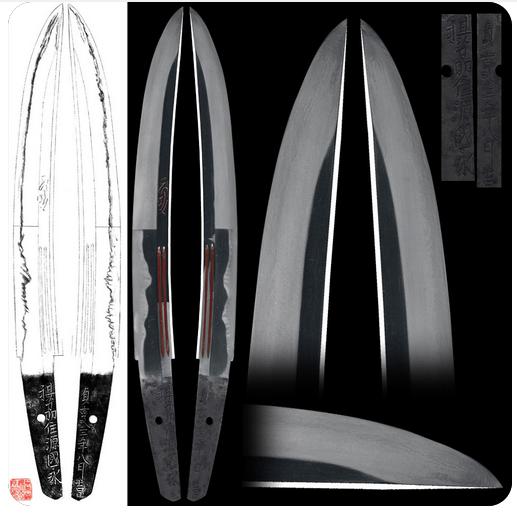
The original O So Raku blade was made by Sukemune in the Muromachi period. It’s got a – well, ridiculously long tip (kissaki) – and a thick heavy deep curve. I don’t know why I liked it but I immediately said, “that!” Then everyone patiently explained to me that it’s the hardest grind for a tanto, and that professional polishers charge double for osoraku blades because of the crazy tip-line, etc. Seriously, though, how can anyone not like that blade? It’s so sexy I bet it’s a pleasure to be stabbed with one.
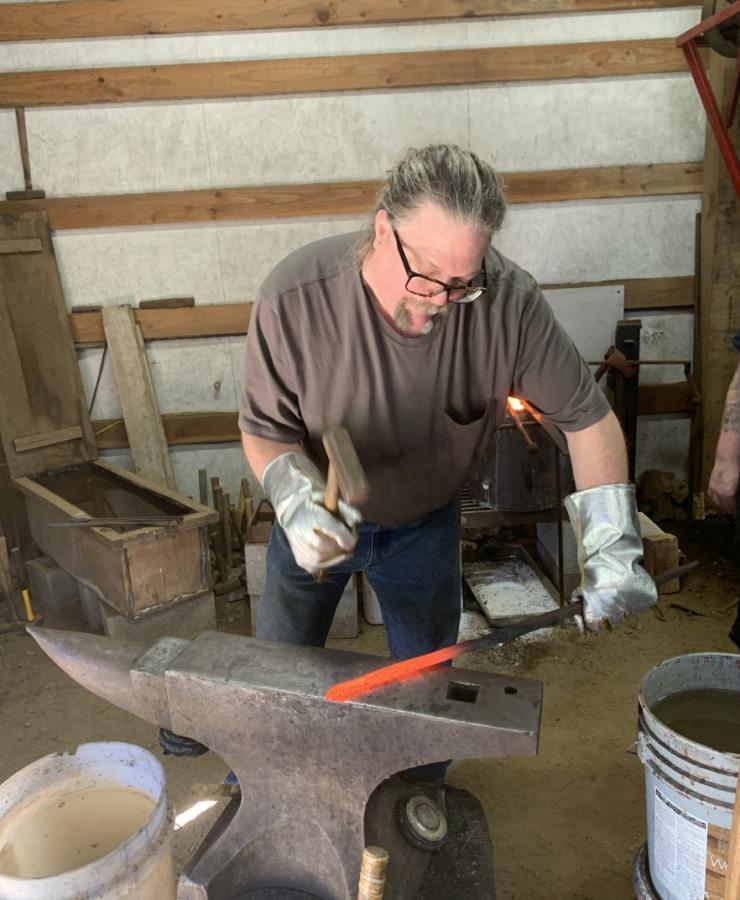
So, that’s the starting-point for forging: a red hot stick-like piece of steel. To shape the tip, the end is cut off at a 45-degree angle, then hammered down and around so that the grain of the metal will follow the line of the tip upward (especially important for an osoraku) then the rest is a matter of beating the middle until it expands, and hammering an approximate shape. From there it’s endless refinement.

In the picture above I am using a 2 1/2lb traditional Japanese ‘dog’s head’ shape hammer. I don’t particularly care about hammers, since I do most of my work with the press, but I didn’t like the dog’s head much since it wants to turn in your hand. I suspect the Japanese make their students use them because a hammer that wants to turn in your hand gives you immediate feedback as you start your swing, if your swing is not perfectly straight.
Osoraku apparently means “perhaps” if you parse the inscription literally.

Will you come out of this with something that needs a name? I am going to suggest “Orfamay.”
This is pretty cool, and thanks for sharing the pics and sharing the story.
Apologies if I came off as dismissive or otherwise negative towards the traditional process in my comment on the previous post, that wasn’t my intention at all, and I’m not great at communication, even less so online… :/
I think there is a lot of value in learning the traditional ways something was created, if nothing else, just for the sake of education and understanding, let alone the craftsmanship or art angles.
out of curiosity, what’s the reasoning for using traditional Japanese style hammers, but recent western style anvils?
On a side note, there is a small forge connected to the shop at my new work place, if it still exists once our current machinist retires later this year, I’m hoping to start trying to use it a bit here and there after hours once I get a bit more established. There’s a decent sized anvil (I’m guessing approximately ~200lbs?), a small propane forge, and a few tongs and hammers. I’ve tried some simple blacksmithing a couple times here and there in highschool and college, by tagging along with friends-of-friends and that sort of thing, but since then I’ve mostly been living in small apartments in urban areas, which isn’t very conducive to setting up a shop, let alone a forge, so I’m kinda low-key excited I might get the opportunity to play around with a small forge and try to learn some simple stuff.
Those are some pretty nifty gloves.
I only know cold metal work not hot, but it has always taken me a while to get along with a hammer. Once I get it, we are good to go but there is definitely a learning curve.
I agree, that blade shape is really beautiful. And OF COURSE it’s the hardest one… but I am not sure I’d be pleased to be stabbed with it!
The Mathematicians by Arthur Feldman (1953, Ziff-Davis) – A science fiction short story in which an-vil is a contraction for half-angel and half-devil. This term was applied by Earthlings to aliens from the dog star Sirius who took over Earth in 1985. They were humanoid, but with wings and tails.
kestrel@#3:
Those are some pretty nifty gloves.
The reflective backs really do work! They’re basically solid felt with leather fingertips. Nobody’s going to do needlepoint in them but they’re pretty nice if you’re working close to the mouth of a forge!
lochaber@#2:
Apologies if I came off as dismissive or otherwise negative towards the traditional process in my comment on the previous post
I didn’t take it that way; you’re fine. There is a lot of B.S. about all of the various knife metals, which serves to conceal that fact that the composition of the blade (and its shape) need to match its purpose. The internets are full of people with opinions, who have never attempted to grind a blade let alone forge one, let alone forge-weld one, let alone smelt their own steel and then forge-weld one. I consider those to be only opinions because they are not informed by experience. Like you, I get tired of that pretty quickly and I tend to try to disengage from that discussion with something evasive.
out of curiosity, what’s the reasoning for using traditional Japanese style hammers, but recent western style anvils?
There is no reasoning. I just picked up that particular hammer because I like a relatively light head and most of the hammers lying around were too heavy. That’s another knife-maker trope: guys who use gigantic hammers then complain about the cartilage in their elbow giving out. I don’t see a connection; I think it’s just bad luck. But, since I mostly use a press and save hammering for correction and fine work, I’ve never had a problem with my elbow. There are some smiths who like Japanese anvils, and some who prefer Italian style, etc. To me, anvils aren’t important. It’s just a shock absorber and a hammer is just a shock generator.
I might get the opportunity to play around with a small forge and try to learn some simple stuff.
That’s super cool! Do they have a grinder?
If you want me to send you a blade blank to work from, let me know. It’s generally best to start with a bit of stock removal so you can see how the shape of the blank and the final shape fit together, which makes it easier to figure out the shape you want to forge to, and then you can figure out the metals.
Reginald Selkirk@#1:
Will you come out of this with something that needs a name?
Probably not. I am not even competent to sign a blade. (picture doing all this stuff then chiselling into the steel…) If I did, I’d probably just use the Kanji for “badger” and not name a blade, though “badger’s claw” would work well for this one.
Marcus@#6
Thank you for the offer, but it’s going to be some time before I even know if I’ll be able to play around in the forge after hours, and even then, I’d be attempting pretty basic blacksmithing stuff. I doubt I’d ever get to the skills needed for bladesmithing.
I mostly just want to play around a bit, and make some simple stuff like wall-hooks and what-not.
make some simple stuff like wall-hooks and what-not
My pan-hooks are twist damascus. That makes them extraordinarily hooky.
Probably a lot easier on the ears as well?
What about trip hammers driven by a waterwheel? That technology is pretty ancient.
rsmith@#10:
Probably a lot easier on the ears as well?
Yes, but… The hydraulic motors are pretty whingy. You have to shout over them. I wear earmuffs and a face-shield-combo and sometimes listen to bluetooth earbuds under the muffs.
What about trip hammers driven by a waterwheel? That technology is pretty ancient.
The Japanese seemed to go more in for having students or assistants do the hammering.
Unsurprisingly Sheffield has examples of hammers from different ages, the water powered ones have “handles” made of entire trunks of oak trees with iron banded round them, three in a row with different heads for the different stages in making scythes. They were used right up until part way through WWII when a nearby bomb blew in the windows of the clay shed, the clay was (can’t remember the correct word) kneaded in a huge trough by walking back and forth with bare feet, and it wasn’t worth the effort to remove all of that clay and start again. The clay was used to make the pots they melted the iron in, without the pots there was no iron so the whole place closed down. Fortunately the site wasn’t anywhere valuable and remained mostly untouched with some of the buildings used for other things, and the on site cottages still lived in, until the city bought the whole lot and turned it into a museum.
I assume the mass produced Japanese officer’s swords of the industrial era onwards to 1945 were nothing like the quality we tend to associate with Japanese blades.
Oh the hell cookie looks awesome. Terrifying, but awesome!